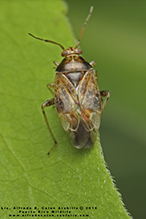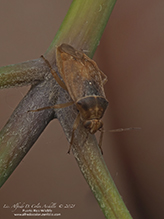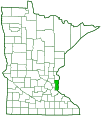Plant bug
(Agnocoris rubicundus)
Conservation • Description • Habitat • Ecology • Distribution • Taxonomy
Conservation Status |
|||
| IUCN Red List | not listed |
||
| NatureServe | NNR - Unranked |
||
| Minnesota | not listed |
||
Description
Agnocoris rubicundus is small plant bug. It occurs in Europe, where it is common, and in North America, where it is uncommon.
Adults are 3⁄16″ (4.7 to 5.2 mm) in length. The body is elongated oval, soft, and reddish-brown to brick red, with both yellowish (pale) and dark brown or blackish-brown (dark) markings.
The head is vertical. There are two large compound eyes and no simple eyes (ocelli). There is a raised ridge (carina) between the eyes, but this feature is difficult to see in photographs. The top of the head (vertex) is reddish-brown with both pale and dark markings. The mouth parts take the form of a long, 4-segmented beak (rostrum) that projects downward and is optimized for piercing and sucking. The antennae are slender, thread-like, and short. They have 4 segments. The first segment does not have numerous flattened hairs. The second segment is very short, shorter than the width of the head.
The exoskeletal plate covering the first segment of the thorax (pronotum) is widest at the base and much narrower behind the head. It has a distinct, exposed collar. There is a small rounded tubercle (callus) at the front outer angle on each side of the pronotum behind the collar. The front half of the pronotum is reddish-brown with both pale and dark markings. The back half is reddish-brown and unmarked. There is a thin, pale, longitudinal stripe in the middle.
The exoskeletal plate between the wing bases (scutellum) is large, triangular, and dark, with a small white spot at the tip. There are two pairs of wings. The front wings (hemelytra) are longer than the hind wings and a little longer than the body. They are held flat over the body when at rest. They are reddish-brown and densely covered with hairs. They have a thickened, leathery part at the base and a thin membranous part at the tip with a clear dividing line between the two. The thickened part is comprised of the narrow area (clavus) behind the scutellum when the wings are closed, and the broad marginal area (corium). At the end of the corium there is a small but distinct triangular area (cuneus). The cuneus is usually pale in the center and always dark at the tip. The membranous portion of each hemelytron is mostly clear but has a dark arc and two closed cells. The veins are pale. The hindwings are completely thin and membranous.
The legs are long, slender, and mostly pale, with reddish-brown and dark spots. The last part of each leg (tarsus), corresponding to the foot, has 3 segments. The first tarsal segment on the hind leg is shorter than the second and third segments together. There is a pair of claws at the end of the third segment. There is a soft pad at the base of each claw. Between the claws there is a pair of long appendages (parempodia). The parempodia are large, membranous, and diverge toward the tip.
Size
Total length: 3⁄16″ (4.7 to 5.2 mm)
Similar Species
Habitat
Poplar and willow
Ecology
Season
Spring through fall
Behavior
Life Cycle
Larva Food/Hosts
Adult Food
Poplar and willow
Distribution |
||
|
Sources |
|
| 11/24/2025 | ||
Occurrence |
||
|
||
Taxonomy
Order
Hemiptera (True bugs, Hoppers, Aphids, and Allies)
Suborder
Heteroptera (True Bugs)
Infraorder
Cimicomorpha
Superfamily
Miroidea
Family
Subfamily
Mirinae
Tribe
Mirini
Genus
Agnocoris
Subordinate Taxa
Synonyms
Agnocoris collaris
Agnocoris fuscoangulata
Agnocoris minor
Agnocoris rubicunda variegata
Agnocoris rubicundus fuscoangulata
Agnocoris rubincudus
Agnocoris schmidti
Agnocoris variegata
Agnocoris winnipegensis
Cyphodema rubicunda
Lygaeus rubicundus
Lygus rubicundus
Lygus rubicundus collaris
Lygus rubicundus minor
Lygus rubicundus schmidti
Lygus rubicundus winnipegensis
Common Names
This species has no common name. The common name of the family Miridae is plant bugs, and it is applied here for convenience.
Glossary
Corium
The thickened basal portion of the front wing that lies between the clavus and the membrane of insects in the family Hemiptera. Plural: coria.
Cuneus
The triangular, hardened, horn-like tip of the forewing of a plant bug (family Miridae).
Hemelytron
The forewing of true bugs (order Hemiptera), thickened at the base and membranous at the tip. Plural: hemelytra.
Ocellus
Simple eye; an eye with a single lens. Plural: ocelli.
Pronotum
The exoskeletal plate on the upper side of the first segment of the thorax of an insect.
Rostrum
The stiff, beak-like projection of the carapace or prolongation of the head of an insect, crustacean, or cetacean.
Scutellum
The exoskeletal plate covering the rearward (posterior) part of the middle segment of the thorax in some insects. In Coleoptera, Hemiptera, and Homoptera, the dorsal, often triangular plate behind the pronotum and between the bases of the front wings. In Diptera, the exoskeletal plate between the abdomen and the thorax.
Tarsus
On insects, the last two to five subdivisions of the leg, attached to the tibia; the foot. On spiders, the last segment of the leg. Plural: tarsi.
Vertex
The upper surface of an insect’s head.
Visitor Photos
Share your photo of this insect.
This button not working for you?
Simply email us at info@MinnesotaSeasons.com.
Attach one or more photos and, if you like, a caption.
Alfredo Colon |
||
 |
 |
|
MinnesotaSeasons.com Photos
|
|

Slideshows

Visitor Videos
Share your video of this insect.
This button not working for you?
Simply email us at info@MinnesotaSeasons.com.
Attach a video, a YouTube link, or a cloud storage link.
Other Videos



